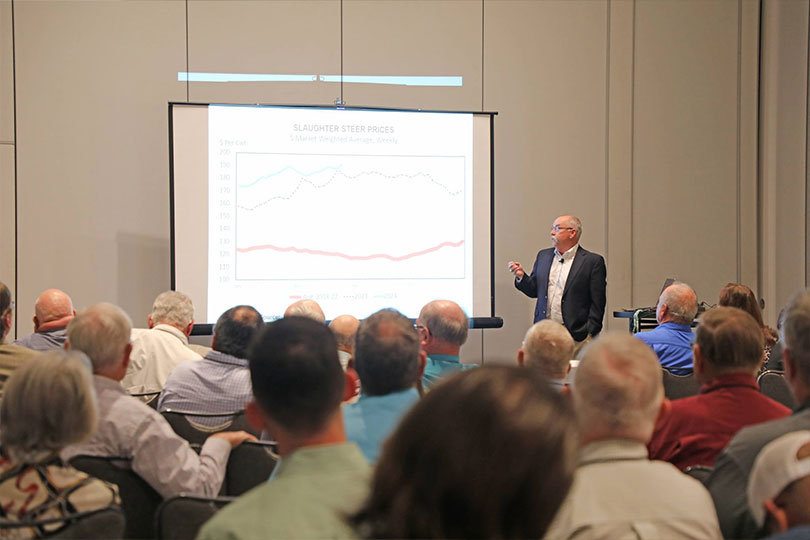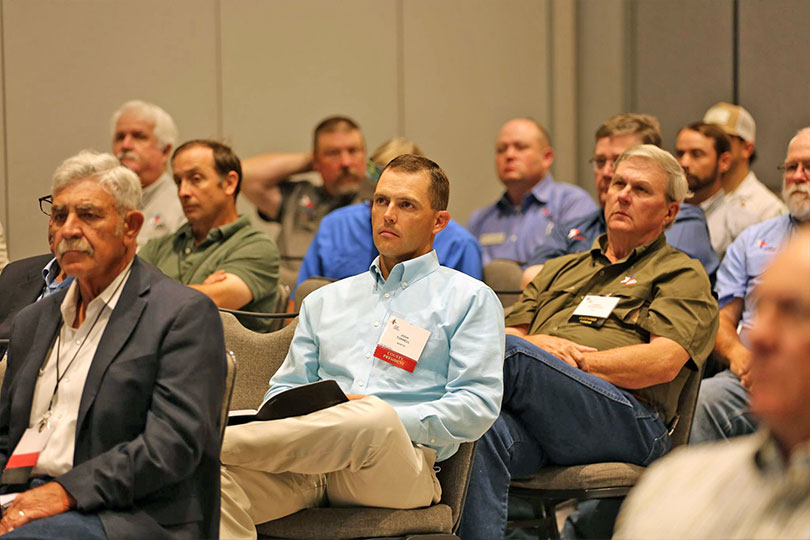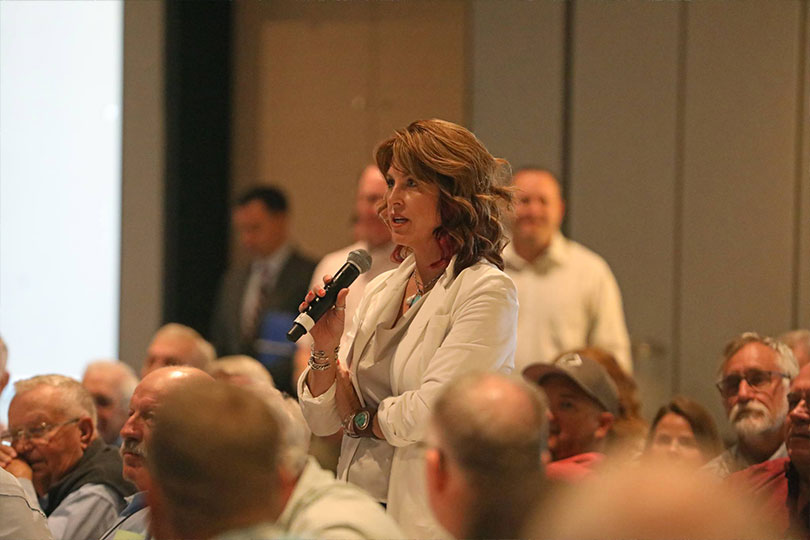By Julie Tomascik
Editor
Consumer trends, mental health and livestock and crop issues were among the topics highlighted during the Texas Farm Bureau Summer Conference.
Nearly 400 farmers and ranchers were in Arlington June 24-26 for the meeting that gave an update on agricultural trends, issues and a political outlook.
Livestock issues
There’s a tighter supply of cattle due to consecutive years of drought, but Dr. David Anderson, AgriLife Extension livestock economist, noted that today’s cow herd is more productive.
“We produce more beef per cow than ever before,” he said. “And we’ve been slow to expand our cow herd with the record high prices those animals are bringing at market, but we still have a steady supply of beef.”
He highlighted risk management tools for ranchers to take advantage of, including Livestock Risk Protection (LRP). The crop insurance product is a flexible strategy that can work for herds of all sizes. LRP issues payments when national prices drop below the producer-selected coverage price.
But highly pathogenic avian influenza has some producers worried.
Texas Animal Health Commission Executive Director Dr. Bud Dinges, DVM, discussed the impacts of H5N1 in dairy cattle and how the flu is impacting poultry producers in Texas and across the nation.
There have been 20 confirmed H5N1 cases in dairy cattle. Nationwide, that total has reached over 120 premises with 12 states being affected.
Dinges stressed the importance of biosecurity practices.
“Biosecurity is paramount as far as the control of this disease and dairy cattle goes,” he said. “We can’t stress biosecurity enough until we really get a better grip on how this is being spread.”

Crop issues
State legislatures continue efforts to restrict pesticide use. Currently, there are over 40 bills introduced in 17 states that seek to restrict neonicotinoids or treated seed, Bayer Crop Science State Policy Director George Gough said.
He also noted there are 32 bills in 14 states that seek to restrict or ban PFAS chemicals in consumer products or aim to change or adopt a PFAS law.
At this time, Texas does not have any bills that address the “forever chemicals.”
Farmers’ access to pesticides is in jeopardy because of misguided state regulatory efforts. If not addressed, this will create a patchwork of state regulations that directly impacts the availability of pesticides.
Federal legislation to address the issue, however, was introduced earlier this year. HR 4288, the Agricultural Labeling Uniformity Act, would ensure uniformity of labeling standards for pesticides that are backed by sound science and approved by the Environmental Protection Agency.
The bill is supported by Texas Farm Bureau, the American Farm Bureau Federation and over 350 organizations.
Glyphosate, and the lawsuits surrounding the herbicide, also remains a trending topic in crop circles.
“Bayer continues to defend glyphosate to governments around the world and in U.S. courtrooms alongside numerous ag stakeholders,” Gough said.
Feral hogs
During a breakout session, David Pipkin with the U.S. Department of Agriculture’s Wildlife Services gave a recap of the feral hog eradication program that was funded through the 2018 farm bill.
He discussed projects in phase one, which focused on watersheds, and phase two projects that focused on crop production impacts.
Pipkin said the funds helped successfully eradicate feral hogs in Dallam County.
“It was the first time to ever remove a county off the map in Texas,” he said.
That makes two feral hog-free counties in Texas—Dallam and El Paso.
Dr. John Tomecek, AgriLife Extension wildlife specialist, elaborated on Kaput Feral Hog Bait trials and the success of the toxicant on private property.
The warfarin-based toxicant was studied in multiple field trials across the state and in different seasons for two years. During the trials, researchers were able to reduce feral hog numbers effectively and efficiently with diligent application of the product.
“Every year we learn about new problems with pigs. Feral hogs are the gift that keeps on giving, and I don’t mean that in a good way,” Tomecek said. “So, is pig control worth it? Yes, every time.”
The manufacturer of Kaput Feral Hog Bait discussed the process for purchasing the restricted use pesticide and the proper protocol for applying the bait.
Landowners who want to use the product must have a private pesticide applicators license and complete a training certification program.
The toxicant can be purchased from one of the roughly 40 local distributors or dealers across the state. A complete list can be found on kaputproducts.com.
Mental health
Farming and ranching are stressful occupations that are associated with increased levels of anxiety and depression.
Multiple studies show that farmer suicide rates are two to five times higher than the national average.
“We have a real mental health crisis in our rural areas, and we’re lacking the tools to effectively deal with it,” Dr. Shannon Ferrell, Oklahoma State University professor, said. “We’re very isolated in agriculture in our workplaces and communities, and mental health issues thrive in isolation.”
He noted it’s especially important to watch out for your neighbors and be familiar with the signs of depression, trauma, stress and suicide.
Consumer trends
Several industry speakers addressed consumer trends and other outside forces that impact agriculture and food production.
Elected officials, consumer preferences and activist groups can influence farm and ranch practices, as well as the environmental, social and governance (ESG) pillars adopted by companies.
“We’re seeing ballot initiatives with the power to fundamentally change our industry and not to promote welfare for animals but to put us out of business,” said Cameron Bruett, JBS USA head of Corporate Affairs.
He referenced Proposition 12, which went into effect in California last year. Pork producers had to adjust housing protocols for breeding pigs to retain access to the California consumer market.
The preferences of “foodies” and the affluent also drive trends in agriculture.
“Their opinions are now pinching agriculture from a number of different directions,” Ray Starling, author of Farmers Versus Foodies, told the group.

Keynote speaker
U.S. Sen. Ted Cruz discussed transportation and infrastructure projects that he successfully championed as legislative co-author. He said the projects will produce new economic growth and thousands of jobs, as well as benefit farmers and ranchers in getting their crops and livestock to markets.
But water issues in the Rio Grande Valley and South Texas shifted the senator’s tone.
“I know farmers and ranchers in South Texas are hurting,” Cruz said. “With the drought you’re facing, I can tell you every single time I sit down with an official from the Mexican government, every time I sit down with business officials from Mexico, the first thing I bring up is you need to honor your treaty obligation.”
He has sponsored legislation to help leverage Mexico into fulfilling its obligations under the 1944 Water Treaty.
Cruz also touched on federal estate tax provisions that are set to expire and need extending, as well as national energy policy.
Additional conference sessions
Additional sessions during the conference covered Producers Owned Beef, fertilizer markets, a primary election recap and a 2025 legislative session forecast, an update on the farm bill and farm labor.
In addition to the sessions, farmers and ranchers could learn more about TFB Health Plans, the newest member benefit—Great Lakes Ag Labor Services, and youth, education and leadership programs available through Farm Bureau.


Leave A Comment